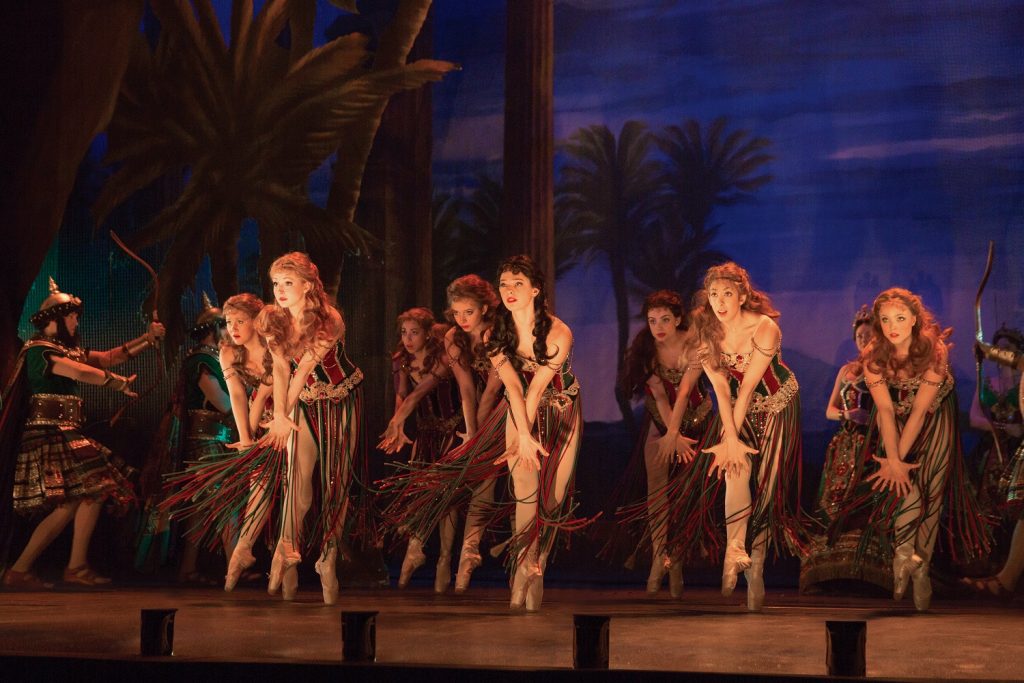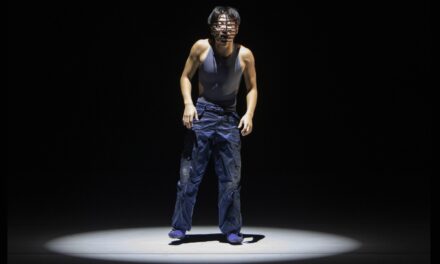I was twelve years old the first time I experienced the extraordinary world of live musical theater. Until that point, I was satisfied with the movie musicals I would watch on television with my grandma as a child––so I was beside myself with glee when my parents surprised me with tickets to see the original Los Angeles production of The Phantom of the Opera at the Ahmanson Theatre.
From the first cord of Sir Andrew Lloyd Webber’s hauntingly melodic orchestration until the last note of the devastating love triangle––which resonated deeply with my (then) melodramatic middle school mindset––I was in lust with the theatrical opulence and decadent voices that dawned the stage. In sleep he sang to me, in dreams, in Drama class, in fifth period Algebra . . . he’s there, The Phantom of the Opera. I suspect most musical theater nerds fall hardest with their first show, as such, Phantom became the benchmark from which I received all musicals hence.
Eventually you get over your first crush, still the Music of the Night continues to cling to me twenty-nine years later, so I leapt at the chance to review a spectacular new North American touring production of Andrew Lloyd Webber’s The Phantom of the Opera at the Segerstrom Center for the Arts.
If you are reading this article, I assume that you are––at the very least––an admirer of musical theater and have undoubtedly seen a production of the longest running show in Broadway history (thirty-one years), so why should you see this revival?
Cameron Macintosh’s new production boasts “newly reinvented staging and stunning scenic design, performed by a cast and orchestra of fifty-two, making this one of the largest productions on tour in North America.” Which is true, but not exactly the romantic pitch you want to hear when contemplating revisiting an old flame. Allow me to elaborate.
The stage was set similarly to that of my childhood memories. We join an auction taking place on the stage of the Paris Opéra House many years following the events of the notorious opera ghost who once caused chaos over a chorus girl. Following the fanciful illumination of “lot 666” the “shattered chandelier” and the strike of the organ into the infamous Overture, the audience is drawn into a lavish scene of a grandiose production being rehearsed on stage. I was elated to see a stage full of performers scattered about in character, doing the things that performers do during a rehearsal.
Director, Laurence Connor clearly understands how to maintain the integrity of a beloved show, whilst capitalizing on the opportunity to navigate a new generation of musical theater devotees, through a twisted tale of love, loss, and ego. I truly appreciated Mr. Connor’s instinct in guiding the performers to make choices that were less theatrical, more honest and nuanced allowing for the drama and subtle comedic moments to resonate with thunderous applause from the always supportive Orange County audience. Even the role of Carlotta, which can easily become a clichéd caricature of what you’d except from an opera star, was played with texture and skill by the vibrant, Trista Moldovan.
I cannot continue raving about the direction of Phantom 2.0 without acknowledging the work of the Set Designer, Paul Brown, who magnificently created oscillating vignettes full of detail that captured the true tone of a 19th century Paris Opera House. Unfolding, twisting, and turning––the sets gave ample room for the imagination to take over––further enhancing the revitalized staging. Seriously, they were every theater kid’s wet dream.
Speaking of dreams, I was ecstatic to see so many dancers employed in a show known (mostly) for its vocal bravado. I give a standing ovation to the late, great Choreographer, Scott Ambler and his Associate Choreographer, Nina Goldman––of whom, I was meant to conduct an interview with, unfortunately our busy schedules did not align. Thankfully, their work did––in their use of transitions, patterns, contemporary partner work, and canons (a phrase of choreography that is performed one after another), the choreography had performers hitting accents in tableaus that complimented each scene and offered additional integrity to the world of musical theater. Where once there was a nearly bare stage, now there is life, movement, and gorgeous use of Lloyd Webber’s music from a visual aspect including a tango of sorts between The Phantom and Christine during The Point of No Return. Because I missed the chance to ask Ms. Goldman myself, I must conclude that she, Mr. Ambler, and Mr. Connor were very collaborative in their gentrification of this already classic production. It comes as no surprise that both Ambler and Goldman hail from the ranks of dancers and choreographers that have worked alongside the stellar Matthew Bourne, who oversees this production.
My favorite moment of this reinvigorated musical happens at the top of Act II during Masquerade. The joyous celebration evoked an en vogue parade of fabulous fashion thanks to the costumes, designed by the late Maria Björnson® which are extraordinary. Then, the fierce dance sequences, including a waltzing circle and a pod of performers moving downstage, while articulating syncopated “arm–ography” channeling the legendary balls originally made popular by Madonna, now (finally) finding mainstream popularity because of television shows like Ryan Murphy’s Pose. The entire production team seemed to capture current cultural trends that should entice a new generation of would-be musical theater monsters, without pandering. Did I miss the opulence of the massive stairway and the commandingly uncomplicated choreography? Yes, for a few seconds. Then I got lost in the maze of gilded mirrors, rich costumes, lively lifts, and smart staging that lured the audience into the gala. The enhanced choreography and additional dancers throughout the performance, triumphantly declared that The Phantom of the Opera is a solid musical.
Where once this show was known for the stars who rocked the roles of The Phantom and Christine Daaé—most notably—Sarah Brightman and Michael Crawford, this renewed adaptation features an ensemble of youthful and dynamic performers who confidently sing, dance, and act the roles, while allowing the iconic music and tragic love story to take center stage. I’m intentionally ending with a shout out to Derrick Davis, whose portrayal of The Phantom was superbly executed vocally and emotionally.
Whether you are a musical aficionado or a newbie, I highly recommend securing your seat at Segerstrom Hall for the return of The Phantom of the Opera now through July 21, 2019. For information and tickets, click here.
Written by Matthew Shaffer for LA Dance Chronicle, July 17, 2019
Featured image: Segerstrom Center for the Arts – The Phantom of the Opera – Derrick Davis as ‘The Phantom’ and Eva Tavares as ‘Christine Daaé’ – Photo: Matthew Murphy















